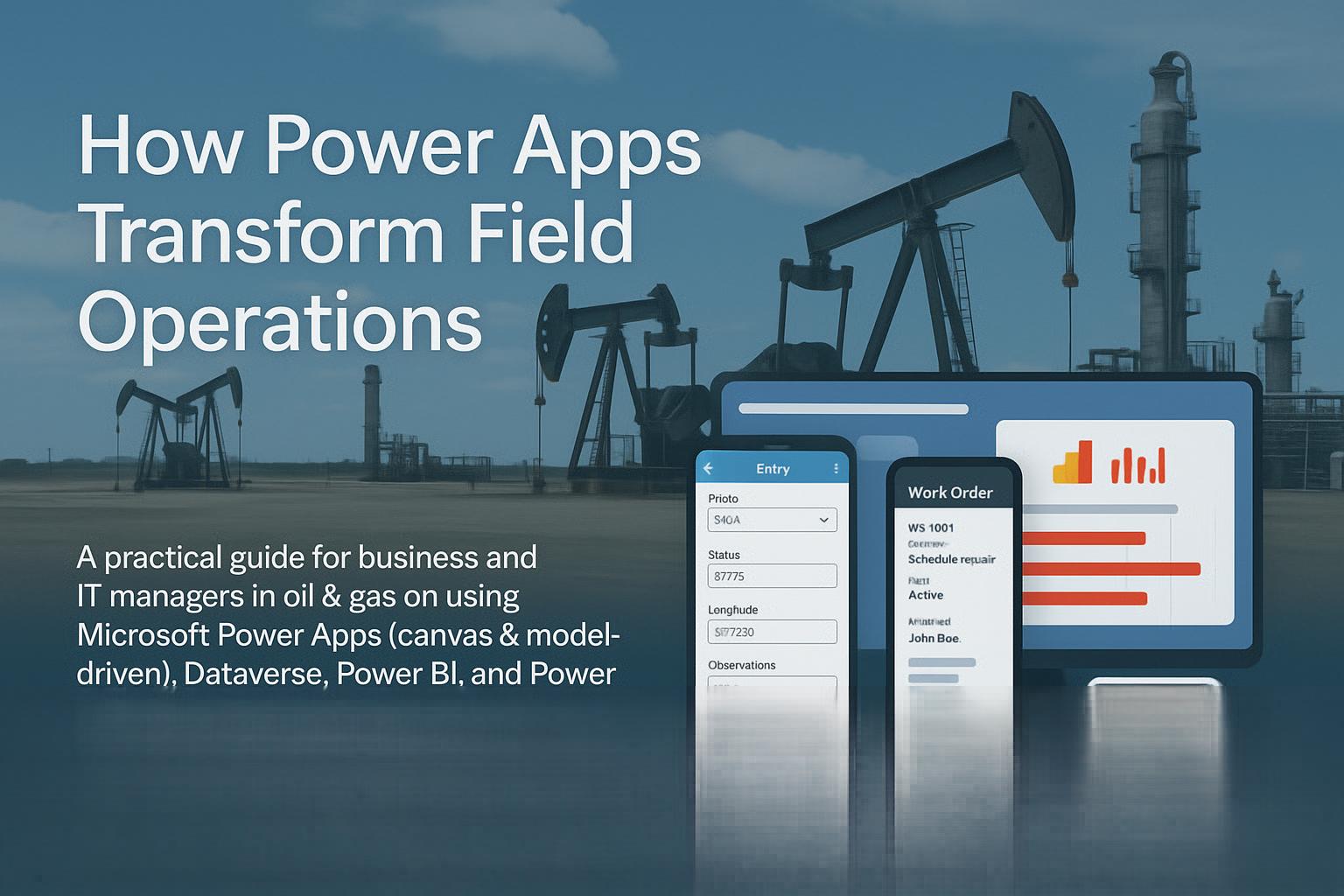How Power Apps Transform Field Operations
Oil & gas field operations are a maze of work orders, inspections, safety checks, and remote assets. Paper, spreadsheets, and clunky legacy tools slow everything down. Microsoft’s Power Platform—Power Apps, Dataverse, Power BI, and Power Automate—gives you a low-code toolkit to digitize those workflows quickly, securely, and at scale.
This post shows business and IT managers how to use the platform to cut downtime, improve safety, and unlock real-time insight—without ripping out your existing systems.
Why the Power Platform fits oil & gas
- Low-code speed + enterprise guardrails. Deliver field-ready apps in days, not months, while IT governs data, security, and lifecycle.
- One data backbone with Dataverse. Standardized tables, role-based security, offline sync, and relationships that model real assets and processes.
- Analytics built in. Power BI turns field data into live dashboards for production, maintenance, and HSE.
- Automation everywhere. Power Automate connects approvals, notifications, and system updates so nothing slips.
See also: Power Platform and SharePoint.
Canvas vs. model-driven: when to use which
Canvas apps
Best for task-specific, mobile-first experiences in the field.
- Pixel-perfect UI for inspections, hazard IDs, material transfers
- Great for device features: camera, barcode/QR scan, GPS
- Connect to many sources; cache data for offline use
Model-driven apps
Best for data-first, end-to-end processes in the back office.
- Auto-generated forms/views over Dataverse tables
- Business process flows for consistent execution
- Rich security and metadata; great for work orders, compliance, and asset lifecycles
Hybrid pattern: Embed a canvas app inside a model-driven app when field UX needs to be specialized but the process is enterprise-grade.
Streamline field data capture & access
Replace paper and spreadsheets.
Build a simple mobile app to capture readings, photos, and notes at the well site. Use dropdowns, validation, and required fields to improve data quality. Auto-tag records with GPS and timestamp.
Design for no-signal scenarios.
Enable offline in Power Apps so crews can work in remote areas. Data syncs to Dataverse when connectivity returns.
Expose the right info at the right time.
Give field crews instant access to production numbers, tank levels, equipment history, and SOPs via intuitive screens—no VPNs or complicated HMIs.
Pro tip: Add quick actions (e.g., “Create Maintenance Request” or “Raise Hazard”) directly on key asset screens to reduce context switching.
Real-time reporting with Power BI
One dashboard, many decisions.
Aggregate production volumes, downtime, open work orders, and HSE incidents into a single Power BI view. Filter by region, pad, well, or crew.
Drill-through to root cause.
Click a spike in downtime to reveal the culprit compressor, mean time to repair, and parts availability.
Turn insight into action.
From a chart, launch a Power App to create a job, or trigger a Power Automate flow to notify a supervisor. Set threshold alerts (e.g., pressure or level anomalies) that post to Teams.
Equipment monitoring & proactive maintenance
Digital inspections.
Convert paper checklists into guided digital rounds with tolerances and conditional logic. Attach photos and annotate defects. Store everything in Dataverse against specific assets.
Telemetry + thresholds.
Surface SCADA/IoT readings (levels, pressures, temperatures) in a Power App. Use flows to alert on abnormal patterns and auto-create work orders.
From reactive to predictive.
Use historical inspection + telemetry data in Power BI (and optionally Azure AI) to spot failure precursors—shifting setpoints, rising vibration, or hotter-than-normal bearings—so you can intervene before downtime.
Quick win idea: A lightweight “Winter Access” app that centralizes plow requests, approvals, and contractor notifications can slash unnecessary dispatches and seasonal costs.
Safety & compliance that people actually use
Tap-to-report hazards and incidents.
A simple mobile form (with photos and GPS) logs hazards in seconds and routes them to the right team. Each submission is tracked to resolution for audit readiness.
Digital JSAs and permits.
Guide crews through the latest procedures, require digital signatures, and enforce prerequisite steps. Store records centrally for trend analysis and inspections.
Regulatory agility.
When rules change, update forms, data fields, and workflows in days—not quarters—so collection and reporting stay compliant without buying niche tools.
Workforce management & automation
Work orders and tasks in one place.
Field staff submit issues from the app; supervisors triage and prioritize in a model-driven view. Use SLAs and reminders to keep throughput high.
Approvals in the flow of work.
Automate invoice pre-approvals, overtime requests, or permit sign-offs. Approvers action requests in Teams; flows post results to vendors or ERPs.
Time and crew scheduling.
Let crews log time on job and shift changes from mobile; auto-feed payroll and dispatch boards.
Result: Less admin, fewer emails, faster turnarounds—and happier field teams.
Integrate without “rip and replace”
Connect to what you have.
Use standard connectors and the on-premises data gateway to read/write with SQL, SAP/Oracle, historians, and custom APIs.
Modernize legacy UX.
Keep your ERP/CMMS as the system of record but layer a clean Power App on top for field entry and status tracking.
Bring SCADA/IoT into the workflow.
Ingest telemetry to the app for context and alerts. Where APIs are missing, consider Power Automate Desktop (RPA) for interim automations.
Data hygiene tips:
- Map assets and relationships clearly in Dataverse (wells → equipment → inspections → work orders)
- Use choice sets and validation at the edge
- Enforce role-based access (least privilege) and data loss prevention (DLP) policies
Architecture blueprint (starter)
- Dataverse: Assets, locations, inspections, hazards, work orders, telemetry refs
- Canvas apps: Field inspections, hazard reporting, material transfer
- Model-driven app: Work management, approvals, compliance oversight
- Power BI: Production, downtime, HSE, backlog KPIs with drill-through
- Power Automate: Alerts, approvals, escalations, ERP/CMMS sync, document generation
- Teams integration: App tabs, adaptive cards for events/approvals
- Security & governance: Environment strategy, ALM, DLP, monitoring
Measuring success (KPIs to track)
- Mean time to repair (MTTR) and planned vs. unplanned work %
- Inspection compliance rate and average defect aging
- Safety incident submission-to-close time
- Seasonal maintenance spend vs. baseline
- First-pass data quality (validation error rate)
- Mobile user adoption and active usage
Getting started (90-day roadmap)
- Weeks 1–2: Discover & design. Prioritize 2–3 high-impact use cases; define Dataverse schema; set environments and DLP.
- Weeks 3–6: Build MVP apps + flows. Deliver one field canvas app (e.g., inspections) and one back-office model-driven app (work orders) with basic dashboards.
- Weeks 7–10: Integrate & secure. Add connectors (ERP, historian), refine roles, enable offline.
- Weeks 11–13: Prove value. Roll to one region/site, capture KPI deltas, and iterate based on field feedback.
Need help turning this into a solution blueprint? Explore our Field Operations solution or talk to us about SharePoint consulting and Power Platform delivery.
Conclusion
The fastest path to safer, leaner, and more predictable field operations is to digitize the last mile—where work actually happens. Power Apps, Dataverse, Power BI, and Power Automate give you a unified way to capture clean data, act on it immediately, and improve every loop from inspection to insight to intervention.
Next step: Book a discovery call and we’ll map your top three use cases to a 90-day delivery plan.

